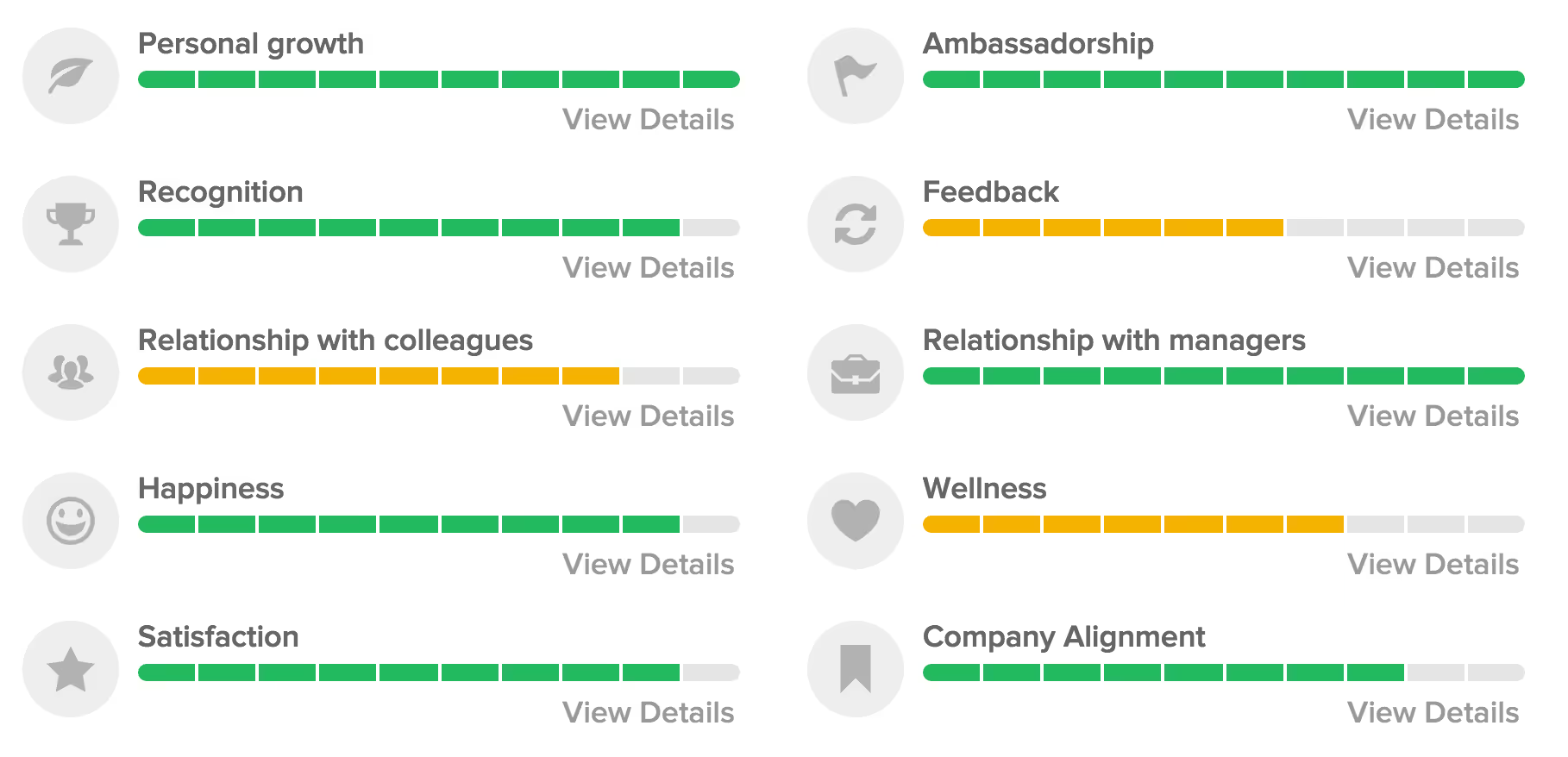The misconception of measuring employee happiness

Discover Workleap Officevibe's benchmark report on 12 key employee engagement metrics

Imagine this: You've loaded the office with work perks — bean bag lounge space, free lunches, and casual Fridays. Everyone seems thrilled and the office is now a joyous place of gathering. And you’re hoping this will rev up everyone’s engine to produce great work. But a few months in, you notice that, while everyone enjoys these perks, overall productivity hasn’t budged, and some projects are still lagging.
This scenario highlights one common misconception in many workplaces: Making the mistake of equating employee happiness with employee engagement. Yes, while happiness is about contentment, it’s often momentary. Engagement, on the other hand, is about long-term commitment and sustained investment in one's work.
Think your organization has confounded these two concepts? Don’t worry. Most leaders have been there, too. The good news is that understanding this distinction can lead to better decision-making (and better organizational outcomes because of that).
Let’s dive in.
The happiness vs. engagement dilemma
Happiness is a great objective for your employees and teams—don’t get us wrong. Who doesn't love seeing their team smile? However, relying solely on happiness as a metric for success can be a trap. A happy employee might enjoy the perks of a job, but without engagement, they might not be fully invested in their work. An employee can love the free snacks but still feel undervalued in their role, unclear about their tasks, or disconnected from the company’s mission.
According to Gallup’s robust State of the Global Workplace report, only 23% of employees worldwide are actively engaged in their jobs — even if over 35% report feeling happy. This discrepancy reveals that happiness level isn’t a reliable indicator of engagement and productivity, as many employees lack a deep commitment to their work despite their well-being.
Why does this distinction matter? Engaged employees are more productive, innovative, and loyal. They bring their best selves to work and drive the company forward. HR professionals, alongside their managers, must look beyond surface-level happiness and cultivate genuine engagement above all since this directly impacts overall success.
Defining employee engagement and happiness
Employee happiness and engagement are often confused, but they are distinct concepts.
Happiness at work might mean employees enjoy their environment or have great relationships with their colleagues — but it doesn’t necessarily mean they’re committed to their roles or feel connected to their company’s mission.
Engagement, on the other hand, involves a deeper emotional commitment to the company that motivates employees to give it their all.
Is happiness enough? The pitfalls of measuring happiness alone
Measuring happiness alone can be misleading. Happy employees may appreciate perks like free lunches or casual Fridays, but if they lack things like employee recognition, feedback, or growth opportunities, then their engagement will suffer.
Happiness alone provides an incomplete picture — which can lead to missed opportunities for meaningful improvements. Without considering other key engagement factors, like personal growth and job satisfaction, companies risk misinterpreting the overall health of their workplace culture.
The importance of measuring engagement
Employee engagement is the golden metric for business success because it snowballs into so many other performance metrics. It’s the emotional anchor that helps employees feel invested in their work and nurtures a sense of purpose. When employees are engaged, they’re more likely to go the extra mile, collaborate with their teammates, and contribute innovative ideas.
All these things lead to better business outcomes—from higher customer satisfaction to increased revenue. Companies with high employee engagement see a 23% increase in profitability and a 78% reduction in absenteeism.
Let’s use a context example. Imagine an engaged employee in a marketing team; that employee won’t just complete their tasks efficiently but will also actively seek ways to improve campaigns they're working on and achieve better results (even if they weren’t asked to do so). They’re motivated by more than just a paycheck — they’re driven by a desire to contribute to everyone’s shared success. It’s that kind of dedication and commitment that sets engaged employees apart and highlights why engagement is so critically important.
It’s worth noting that performance aside, engaged employees are more likely to stay with the company, too — reducing turnover costs and contributing to a sustained positive workplace culture.
Other metrics to consider
Beyond just happiness and engagement, understanding the full employee experience requires looking at a few other key metrics:
Job satisfaction: This goes beyond basic happiness to include how content employees are with their job roles, responsibilities, and daily tasks. It reflects whether they find their work meaningful and aligned with their skills and interests.
Ask employees:
- "How do you feel about your current job responsibilities and tasks?"
- "Do you find your work meaningful and aligned with your interests?"
- "Is there anything about your role that you would like to change or improve?"
Workplace culture: The environment and ethos of the organization play a huge role in employee experience. This includes company values, traditions, social interactions, and the overall atmosphere at work. A positive culture fosters collaboration and motivation.
Ask employees:
- "How would you describe the work environment and culture here?"
- "Do you feel that the company values align with your personal values?"
- "What aspects of our workplace culture do you enjoy the most?"
Employee morale: This metric captures the general mood, confidence, and outlook among employees. High morale often translates to higher productivity and lower turnover. It reflects how employees feel about their work environment and their place within it.
Ask employees:
- "How do you feel about coming to work each day?"
- "Do you feel supported and appreciated by your colleagues and management?"
- "What can we do to boost team morale?"
Professional development: Opportunities for career growth and skill development are crucial. Employees want to know they have a future in the company and that their skills are being enhanced. This includes training programs, mentorship, and clear career progression paths.
Ask employees:
- "Are you satisfied with the opportunities for career growth here?"
- "What skills or areas would you like to develop further?"
- "Do you feel you have clear career progression paths available to you?"
By considering these metrics and asking the right questions to prompt employees, managers can gain a more holistic view of their team’s true engagement levels and find out where they can provide more support.
How to measure engagement
To accurately measure engagement, it's important to use a comprehensive approach that goes beyond simple happiness surveys. Here’s an easy step-by-step guide to keep in your back pocket!
{emphasize}
A guide to measuring engagement
Step 1: Conduct regular pulse surveys
- Frequency: Weekly, bi-weekly, or monthly.
- Focus: Ask about workplace satisfaction, engagement levels, and areas for improvement.
- Pro tip: Keep surveys short and focused to ensure higher participation rates. Questions like "What recent accomplishments are you most proud of?" or "What obstacles are you currently facing?" can yield valuable insights.
Step 2: Hold one-on-one meetings
- Frequency: Bi-weekly or monthly.
- Focus: Discuss personal goals, feedback, and any concerns.
- Pro tip: Use this time to provide constructive feedback and recognize achievements. Start with questions like, "How are you feeling about your current projects?" or "What support do you need to reach your goals?"
Step 3: Use 360-feedback
- Frequency: Annually or bi-annually.
- Focus: Gather feedback from peers, subordinates, and supervisors.
- Pro tip: Ensure anonymity to get honest and useful feedback. Ask questions such as, "How effectively does this person collaborate with the team?" or "What areas of improvement would you suggest?"
Step 4: Monitor key metrics
- Frequency: In-real time thanks to data analytics tools
Focus: Track productivity, absenteeism, and turnover rates.
- Pro tip: Use these metrics to identify trends and address issues proactively. Consider questions like, "What patterns are we seeing in absenteeism rates?" or "How do turnover rates correlate with engagement survey results?"
Step 5: Foster open communication
- Frequency: Daily
- Focus: Create channels for employees to voice their opinions and suggestions.
- Pro tip: Implement an open-door policy and use digital tools for anonymous feedback. Encourage dialogue with prompts like, "What changes would improve your daily work experience?" or "How can we better support your professional growth?"
{emphasize}
The role of managers in driving engagement
Managers are the MVPs of employee engagement. We’re not just saying that—research shows that managers account for 70% of the variance in employee engagement. Their daily interactions, feedback, and support can make a serious difference for the rest of their teams.
Here's how you can drive engagement effectively with your own team:
- Personal growth: Offer chances for skill development and career growth. Ask, "What new skills are you excited to learn?"
- Ambassadorship: Check how proud employees are and if they’d recommend the company. Ask, "Would you tell a friend to work here?"
- Recognition: Make sure you’re giving props often and meaningfully. Ask, "Do you feel recognized for your work?"
- Feedback: Give regular, useful feedback. Ask, "Are you getting the feedback you need?"
- Relationships with peers: Encourage strong bonds among teammates. Ask, "How’s your connection with your coworkers?"
- Relationships with managers: Build solid rapport between managers and employees. Ask, "How’s your communication with your manager?"
- Happiness: Monitor your overall happiness at work and home. Ask, "Are you satisfied with your work-life balance?"
- Wellness: Support physical and mental health. Ask, "How can we help with your well-being?"
- Job Satisfaction: Check satisfaction with pay and benefits. Ask, "Happy with your job benefits?"
- Company alignment: Make sure everyone’s on the same page with the company’s mission. Ask, "Do you get and support our mission?"
Don't just focus on perks: Invest in meaningful engagement
While we love little moments of extra love and support, like free lunches, they don’t address the core drivers of engagement.
Here are some actionable engagement ideas to keep in mind:
- Build personal development plans: Collaborate with employees to set clear, achievable goals that align with their career aspirations. Offer opportunities for training and development to help them grow.
- Practice regular feedback and recognition: Implement a system for regular feedback and employee recognition. Celebrate both small and big wins, and ensure feedback is constructive and frequent.
- Create mentorship programs: Pair employees with mentors to provide guidance, support, and insight into career development. This fosters a culture of learning and growth.
- Provide flexible work arrangements: Allow for flexible working hours or remote work options. This shows trust in employees and helps them balance work and personal life effectively.
- Look into well-being initiatives: Invest in wellness programs that address physical, mental, and emotional health. This could include gym memberships, mental health days, or stress management workshops.

The key is to strike the right balance between happiness and engagement activities. To truly engage employees, invest in meaningful initiatives that foster personal growth, recognition, and a strong sense of purpose first — and leverage perks as complementary assets!
Beyond happiness: Fostering true engagement
In the quest to build a thriving workplace culture, it's crucial to look beyond surface-level happiness. Real engagement comes from creating an environment where employees feel recognized, valued, and challenged. By measuring and investing in engagement rather than just happiness, organizations can unlock the full potential of their workforce, leading to higher productivity, lower turnover, and overall business success.
Remember, it’s not just about keeping employees happy — it's about engaging their hearts and minds.
Give HR and managers the clarity, confidence, and connection to lead better every day.


%20(1).avif)


.avif)
.avif)








